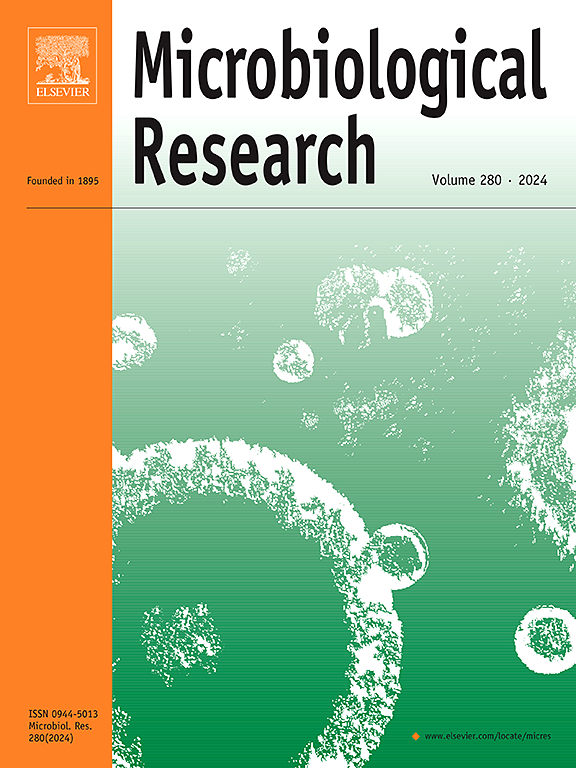ROS-induced allosteric regulation of NikR coordinates HP0910-mediated OMP2 methylation to modulate H. pylori biofilm dynamics and therapeutic targeting
IF 6.9
1区 生物学
Q1 MICROBIOLOGY
引用次数: 0
Abstract
Biofilm formation represents a critical survival strategy for Helicobacter pylori (H. pylori), facilitating antibiotic resistance and chronic colonization. In this study, we demonstrate that reactive oxygen species (ROS) released by macrophages enhance H. pylori biofilm formation through a novel epigenetic pathway. Transcriptomic and genetic analyses revealed that the nickel-responsive regulator NikR is allosterically activated by ROS, transitioning from its apo to holo conformation. This conformational shift markedly represses the expression of the DNA methyltransferase HP0910, resulting in hypomethylation of the omp2 gene, which encodes an outer membrane protein (OMP), and subsequent OMP2 overexpression, as validated by quantitative reverse transcription PCR (qRT-PCR) and reporter assays. Elevated OMP2 levels enhance extracellular polymeric substance (EPS) production, leading to a significant increase in biofilm biomass and thickness, as quantified by crystal violet staining and confocal laser scanning microscopy (CLSM). ROS scavenging reverses this phenotype, promoting biofilm dispersal. Furthermore, molecular docking and functional assays identified flopropione, a small-molecule compound targeting OMP2, led to an approximately 80 % reduction in biofilm biomass in vitro. When combined with standard triple therapy (omeprazole, amoxicillin, and clarithromycin), flopropione significantly improved bacterial clearance (>2-log10 reduction) in a murine infection model. Collectively, our findings elucidate the ROS–NikR–HP0910–OMP2 signaling axis that regulates H. pylori biofilm dynamics and identify flopropione as a promising anti-biofilm therapeutic candidate against multidrug-resistant infections.
ros诱导的NikR变构调控协调hp0910介导的OMP2甲基化,调节幽门螺杆菌生物膜动力学和治疗靶向
生物膜的形成是幽门螺杆菌(h.p ylori)的关键生存策略,促进抗生素耐药性和慢性定植。在这项研究中,我们证明了巨噬细胞释放的活性氧(ROS)通过一种新的表观遗传途径促进幽门螺杆菌生物膜的形成。转录组学和遗传学分析显示,镍响应调节因子NikR被ROS变构激活,从载脂蛋白构象转变为全息构象。这种构象转移明显抑制DNA甲基转移酶HP0910的表达,导致编码外膜蛋白(OMP)的omp2基因的低甲基化,并导致omp2过表达,定量反转录PCR (qRT-PCR)和报告基因分析证实了这一点。通过结晶紫染色和共聚焦激光扫描显微镜(CLSM)可以量化,OMP2水平升高会增加细胞外聚合物(EPS)的产生,导致生物膜生物量和厚度显著增加。活性氧清除逆转了这种表型,促进了生物膜的扩散。此外,分子对接和功能分析发现,氟丙酮是一种靶向OMP2的小分子化合物,可使体外生物膜生物量减少约80% %。当与标准三联疗法(奥美拉唑、阿莫西林和克拉霉素)联合使用时,氟丙酮显著提高了小鼠感染模型中的细菌清除率(降低2-log10)。总之,我们的研究结果阐明了调控幽门螺杆菌生物膜动力学的ROS-NikR-HP0910-OMP2信号轴,并确定氟丙酮是抗多药耐药感染的有前途的抗生物膜治疗候选药物。
本文章由计算机程序翻译,如有差异,请以英文原文为准。
求助全文
约1分钟内获得全文
求助全文
来源期刊

Microbiological research
生物-微生物学
CiteScore
10.90
自引率
6.00%
发文量
249
审稿时长
29 days
期刊介绍:
Microbiological Research is devoted to publishing reports on prokaryotic and eukaryotic microorganisms such as yeasts, fungi, bacteria, archaea, and protozoa. Research on interactions between pathogenic microorganisms and their environment or hosts are also covered.
 求助内容:
求助内容: 应助结果提醒方式:
应助结果提醒方式:


